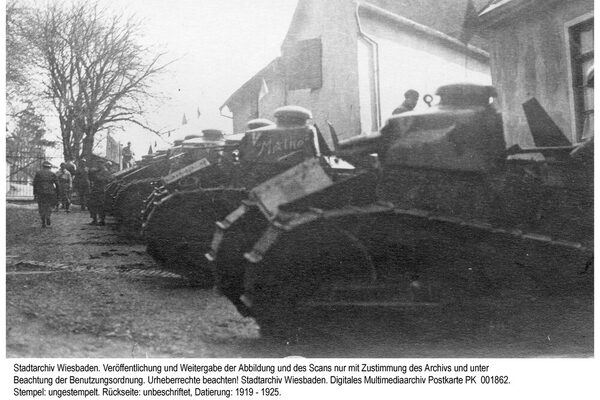Rhineland occupation
Following its military defeat in the First World War, the German Reich had to agree to the Compiègne Armistice Treaty in 1918, Article V of which stipulated the occupation of the areas on the left bank of the Rhine, including the bridgeheads of Aachen, Cologne and Mainz with a radius of 30 km and the fourth bridgehead of Kehl (Grand Duchy of Baden) with a radius of 10 km. The military seizure of the German territories was intended to prevent a rapid deployment of German troops and serve as a means of exerting pressure for the fulfillment of the upcoming peace negotiations and the enforcement of reparation demands. The Treaty of Versailles provided for occupation for a period of 15 years.
The occupied territory was administered by the Inter-Allied Rhineland Commission based in Koblenz. Wiesbaden was part of the Mainz bridgehead and was occupied by French troops on December 13, 1918. For the city, this meant restrictions in the areas of communication, freedom of travel and economic life. The spa and tourist industry, which had already been severely affected by the war, came to an almost complete standstill. Food and fuel were in short supply. Many Germans felt the defeat in the First World War and the control by foreign troops as a disgrace. The French supported separatist efforts in the Rhineland and pursued a French cultural policy in the Rhineland. In 1923, the Ruhr region was occupied from the Rhineland in order to exert pressure on the Reich government and thus achieve fulfillment of the reparations provisions.
In the course of the Ruhr War, the separatists received renewed support, but the separatist movement was only able to hold out until the beginning of 1924. Instead of the French, who vacated the occupation zone by the end of January 1926, British occupation troops were transferred to Wiesbaden, for whom the former Hotel Hohenzollern served as headquarters. In 1929, the headquarters of the Inter-Allied Rhineland Commission was moved to Wiesbaden. By the end of the year, the last remaining British and Belgian contingents had also left the Rhineland.
The evacuation of the British army and its members began in Wiesbaden on September 14, 1929, and the last troops left on December 12. At the end of November 1929, French troops were again deployed to Wiesbaden as a guard of honor for the Inter-Allied Rhineland Commission. On June 30, 1930, the Allied occupation of the Rhineland ended after almost 12 years, five years earlier than stipulated in the Treaty of Versailles. The withdrawal of the Allied troops triggered a wave of national enthusiasm throughout Germany. The celebrations also began in Wiesbaden with a night-time rally in front of the town hall. The festive final act was the visit of Reich President Paul von Hindenburg on 21.07.1930.
Literature
Kolb, Eberhard: The Peace of Versailles, Munich 2005.
Krüger, Peter: The foreign policy of the Republic of Weimar, Darmstadt 1985.
Munz, Marius: "Wiesbaden est boche, et le restera." The Allied occupation after the First World War 1918-1930, Wiesbaden 2012.
